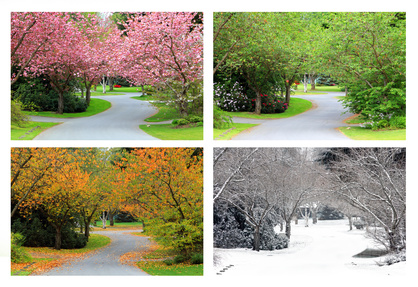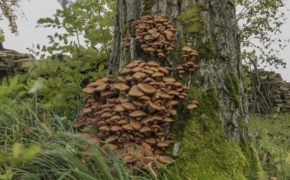
Get a quick no obligation quote It’s free and will only take a jiffy!
Trees Through the Seasons
Trees are amazing feats of nature. In fact, some of the things they do cannot fail to intrigue us.
Did you know for example that trees are connected to each other through a network of underground fungi? That they share water and nutrients through these networks and use them to ‘talk’ to each other, sending out messages warning of disease, drought and pest attacks? It is a proven fact that other trees change their behaviour when they receive such messages. The scientific name for this is mycorrhizal networks, but it’s better known as the ‘wood wide web’.
Through the seasons of the year, trees change their behaviour in line with the transforming weather conditions. We thought it would be interesting to take a look at precisely what goes on as winter turns to spring, spring flourishes into summer and summer shifts to the glorious golden hues of autumn.
Trees in winter
Of course we all know that deciduous trees shed their leaves come the winter, but it is less widely known just how they manage to survive sub-zero temperatures.
Just like some animals that hide away and sleep through the winter months, so trees enter a period of dormancy as the colder weather kicks in. This goes for both deciduous and coniferous trees. This is precisely what keeps them alive during the winter.
Dormancy sees everything slowing down. Trees will generally stop growing; their energy consumption will drop drastically and their metabolism falls too.
You’ll know when dormancy has started as the leaves start to fall. Because leaves require an enormous amount of energy to maintain, this works well for the tree during winter when nutrients are sparse and water is frozen and hard to absorb.
Trees in spring
Trees start to grow again and burst into flower when spring arrives. The onset of the warmer weather and longer daylight spells spur this on.
Some trees flower first then the leaves appear afterwards whilst others grow their leaves before breaking into blossom. Most buds that open in the spring were actually formed during the previous summer. These buds contain what will soon become this year’s new shoots which have gratefully been protected from the harsh winter frosts by bud scales. Brilliantly and in line with the intelligence of trees, the buds are not tricked by mid-winter thaws and instead stay nicely tucked up until true spring arrives.
Trees are not pre-programmed to burst into life a certain number of days following the start of their dormancy. If this was the case then every tree would start to spring into life on exactly the same day each year. In actual fact, the breaking out of buds can vary each year by a number of weeks, and contrary to popular belief, it is actually prompted by cold rather than warm temperatures.
Before buds can break, trees must be exposed to very cold temperatures. Only when that occurs followed by exposure to warmer temperatures will it occur. Such climatic changes alter the hormone and enzyme balance that promote and inhibit growth. The timescales involved all vary depending upon the species of tree.
Once the leaves sprout, they set to work very quickly, much like a factory. They capture energy and sunlight and convert it into sugar to support the tree in its forthcoming summer growth. This is known as photosynthesis and it all occurs in the cells of the leaves through something called chlorophyll. Chlorophyll is what gives leaves their green colour.
Trees in summer
Between June and August, trees go through an abundant growth spurt. Some will grow at exceptional rates, possibly up to 2cm per day! The girth of some trees can expand considerably in just a few weeks. Most growing happens in the early part of summer.
During the summer, there is much competition between trees for space, light and nutrients. Trees grouped closely together will either aim high or spread out and, as any space becomes available, they will quickly move into it. Any tree showing signs of weakness will experience rapid demise as the dominant neighbours flex their muscles.
It is during summertime that the buds that will burst open in spring are formed. This usually happens towards the end of the season, mostly in August. The process is known as lignification and it’s the start of the tree making early preparations for winter. Late summer also sees trees start to store up reserves to get them through the winter and ready for the start of the new growing process in the following spring.
Summer is also the season for fruit. This is the season when you’ll see the likes of apples, pears and a variety of berries, some of them edible, others most definitely not. Fruits will only appear on a tree once the flowers have been pollinated. Pollination varies from species to species; sometimes it will be by wind, and for other trees it will be via insects. Some species grow both male and female flowers on the same tree (monoecious) and others have the male flowers on one and the female on another (dioecious).
When it gets to late summer, trees stop producing wood cells so that they can plough their energy into storing reserves and producing buds. The wood produced during this time is known as ‘late wood’. This is a different colour to ‘early wood’ which grows in the spring. This difference in colour is how you can identify the annual growth rings that enable you to tell the age of a tree.
Trees in autumn
Autumn is a much loved season for those who appreciate trees. And with the rich kaleidoscope of golds, auburns, coppers and reds delighting the eye, there is no wonder.
Abscission is the name given to the process that triggers the shedding of leaves in late autumn. Early on in the process, trees reabsorb vital nutrients from the leaves to store for later use within their roots.
Leaf shedding in deciduous trees is sparked by the production of a chemical known as abscisic acid (ABA). This collects in the terminal bud, sending a signal to the leaf to break off. ABA is also responsible for suspending growth in both coniferous and deciduous trees. This saves a lot of energy.
The transformation of a tree’s leaves from green through yellow and eventually red or copper occurs when the tree has absorbed all the food it possibly can from the leaves. As the sunlight becomes less intense, the leaves stop making food and the chlorophyll starts to break down into colourless compounds. This reveals yellow pigments and then other chemical reactions lead to red hues coming to light.
Deciduous trees mostly have broad leaves. These would be seriously damaged during cold spells, which is why they must be shed during autumn before the freezing temperatures of winter arrive. Leaf shedding also assists with pollination during the spring. Without a barrier of leaves, wind-carried pollen enjoys greater freedom to travel.
Tree care
So there you have it: trees through the seasons. What an interesting and intelligent life form they truly are!
If you have any trees on your land that could do with a little care and attention and you’re not quite sure where to start, why not give T.H. Tree Services a call for expert assistance?
Amazing service from Mark and his team. We had a problem with Bamboo that had spread from a neighbours garden. Mark kept us informed with regular phone calls and images of how the work was progressing, as we were not present the house. 1st class job and a pleasure to do business with this company.
Thank you Colin and Gillian for your kind review. It was a pleasure to be able to clear the bamboo for you.








